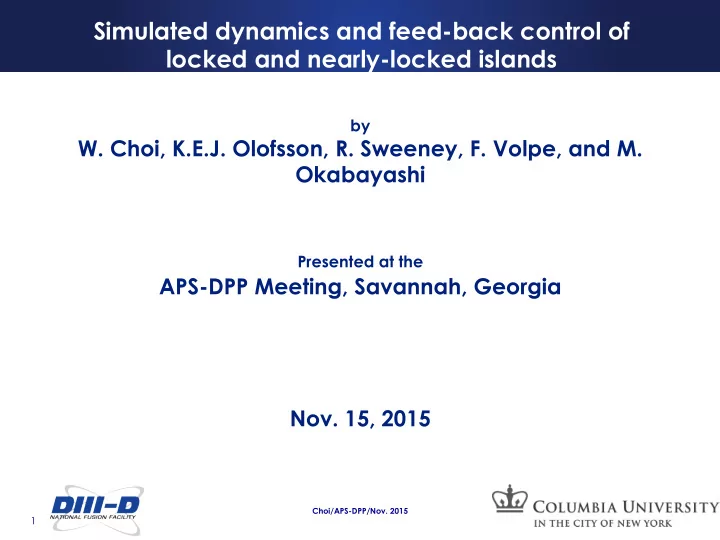

Simulated dynamics and feed-back control of locked and nearly-locked islands by W. Choi, K.E.J. Olofsson, R. Sweeney, F. Volpe, and M. Okabayashi Presented at the APS-DPP Meeting, Savannah, Georgia Nov. 15, 2015 Choi/APS-DPP/Nov. 2015 1
Abstract A model has been developed at DIII-D to predict the dynamics of • saturated m/n = 2/1 tearing modes subject to various torques. Modes interact with the error fields, magnetic perturbations applied • by internal and external active coils, the conducting wall, and the graphite tiles. Model also accepts input auxiliary torques (viscous drag, neutral • beam torque, etc). Maximum entrainment frequency is dependent on island width and • current in control coils. Applicable in assisting island suppression with electron cyclotron • current drive, as well as to prevent mode locking and possible disruption. *This work was supported in part by the US Department of Energy under DE-SC0008520. Choi/APS-DPP/Nov. 2015 2
Motivation Neoclassical Tearing Modes (NTMs), or magnetic islands, • often appear in high performance plasmas and can degrade confinement These NTMs can slow and lock in the lab frame, becoming • Locked Modes (LMs), which can grow in size and may lead to disruptions The toroidal phase of LMs can be controlled through Resonant • Magnetic Perturbations (RMPs), which is needed to align the LM with electron cyclotron current drive (ECCD), an effective suppression technique Choi/APS-DPP/Nov. 2015 3
Introduction Choi/APS-DPP/Nov. 2015 4
Island and coils being modeled at DIII-D • Island is associated with a moment of inertia (I) and current (J s ) • Torque from Currents in the I-coils (J b ) and C-coils (J c ) • effect of resistive wall is accounted for (B w ) General equation of motion accepted as auxiliary torque Steady state entrainment Choi/APS-DPP/Nov. 2015 5
System of equations modeling 2/1 island dynamics (x 1 , x 2 ) are the magnetic field at • the wall (Bw) x 3 is angular velocity of the • mode ( ω ) (x 4 , x 5 ) is the current associated • with the mode (J s ) (J 1 b , J 2 b ) and (J 1 c , J 2 c ) are the • prescribed currents in the I- and C-coils respectively τ is the resistive decay time of • the wall Choi/APS-DPP/Nov. 2015 6
Simulations Choi/APS-DPP/Nov. 2015 7
Study of mode locking to error field (EF) Study of tendency of mode locking to EF • – only include wall braking and constant EF – does not have I-coils or C-coils Large EF No EF Small EF Phase [°] Time [ms] Time [ms] Time [ms] Choi/APS-DPP/Nov. 2015 8
Variance decreases as EF amplitude increases For given EF amplitude, varied Final position variance for • • initial mode position different EF amplitudes variance [° 2 ] final position [°] Error Field amplitude (a.u.) Initial position [°] variance = Σ (final position) 2 9
Simulation of “pre-emptive” I-coil entrainment Case 1: Successful entrainment Rotating n=1 field applied by I-coil before mode appears • Simulation confirms expectation that, as mode slows down, it • will lock directly to the applied, rotating resonant magnetic perturbation (RMP) Successful entrainment of a 5 cm island at 130 Hz with 3 kA in I-coils Choi/APS-DPP/Nov. 2015 10
Case 2: Failed entrainment failure to entrain due to smaller I-coil amplitude • mode continuously tries to align with RMP • Failed entrainment of a 5 cm island at 130 Hz with 1.5 kA in I-coils Choi/APS-DPP/Nov. 2015 11
Contour plot of maximum entrainment frequency Result of competition between wall braking and EM torque from • RMP large islands experience • strong wall braking small islands experience • weaker interaction with RMP Choi/APS-DPP/Nov. 2015 12
Steady-state wall torque experienced by entrained mode assuming steady-state entrainment • braking torque from the wall is balanced by applied torque • from RMP Choi/APS-DPP/Nov. 2015 13
Experimental Result Choi/APS-DPP/Nov. 2015 14
Experimental result at DIII-D: pre-emptive entrainment successful Rotating phase: Locked to rotating RMP phase: signal lost at 2514 ms signal found at 2516 ms n1rms = 17G freq = 70 Hz n1freq = 1.04 kHz Used 3.6 kA in I-coils, rotating at 70 Hz Choi/APS-DPP/Nov. 2015 15
Example of repeated mode disappearance? Attempted 70 Hz entrainment • Smooth rotation between 2200 ms to 2300 ms • Observe mode amplitude disappearance and phase flip • Causes still under investigation • Choi/APS-DPP/Nov. 2015 16
Conclusions A model has been developed to study the dynamics of • magnetic islands under various torques: wall braking, applied fields, error fields, etc. Mode entrainment by pre-emptively rotating RMP was shown • to be a feasible way of preventing mode locking An experiment on this technique was recently performed, • data still being analyzed Future work will be to apply this model to a feedback • controller Choi/APS-DPP/Nov. 2015 17
Entrainment and Torque contour at NSTX coils: external 1x6 coils at mid-plane • major radius: 0.86 m • wall time: 5 ms • density: 3x10 19 m -3 • B t : 0.18 T • Choi/APS-DPP/Nov. 2015 18
Recommend
More recommend